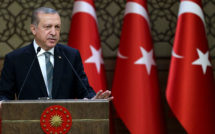
This is part of our special feature on Radicalism and Violence.

The Extreme Gone Mainstream is an important, meticulously researched, and timely—in fact, increasingly so by the day—contribution to scholarship on radical politics in Germany, with implications for other contemporary democracies. A second monograph on this topic by Cynthia Miller-Idriss, a leading sociologist of nationalism and symbolic politics in Europe and the United States, this magisterial analysis of thousands of exhaustively coded images, field notes from multiple trips to Germany, and dozens of in-person interviews persuasively documents the power of coded symbols adorning everyday clothing to generate and reinforce exclusionary collective identities and support a nationalist discourse and political community that until recently had been relegated to the fringes of German society.
As Miller-Idriss demonstrates, a sizeable commercial industry, dominated by brands like Thor Steiner and Ansgar Aryan, has emerged as a popular source of fashionable clothing among German youth. For some, consuming these products enables teenage rebellion against authority with relatively benign consequences, but for many others it provides a channel into extremist communities and movements. In the process, these brands legitimize neo-Nazi ideology and reposition it as an acceptable strategic tool for rescuing German identity from under the yoke of liberal political correctness and historical amnesia. This, in turn, feeds into the swelling tide of extremism that threatens to alter German political culture for decades to come.
A mere few years ago, such observations could be dismissed by some as esoteric, dealing with a fringe phenomenon unlikely to have broader impact on German political culture. In writing this book, however, Miller-Idriss already knew what many of us would only learn later: Germany was well on its way to joining the ranks of democracies plagued by an upsurge of radical-right politics, which are fed in no small way by precisely the type of extremist commercial culture documented in her research. Indeed, “Extreme Gone Mainstream” may be an apt catchphrase for the politics of today more generally, as norm violations that were unthinkable not so long ago are becoming increasingly routine and normalized. That this can happen in a country so deeply devoted to drawing a thick line between its sordid, violent past and its liberal, progressive present suggests that no democracy is immune from the nationalist pressures generated by grassroots movements, political elites, and as this book suggests, lucrative cultural industries.
Besides its status as a weathervane for radical politics, The Extreme Gone Mainstream makes important substantive, theoretical, and methodological contributions likely to be of considerable interest to students of political culture. As I have already suggested, its signal substantive contribution lies in its sophisticated and visually rich account of how far-right imagery has been successfully mainstreamed in German consumer culture and, as a result, how it has come to occupy an important place in the cultural repertoires of working class youth. This process of normalization both reflects a changing understanding of nationhood in Germany—characterized by a long-simmering backlash against the purging of the country’s Nazi past and with it, of meaningful sources of national pride—and feeds back into the further popularization of far-right ideas through processes of peer-group cultural diffusion. The clothing, which is remarkable in its creative skirting of hate speech laws, can therefore be seen as an important element in an endogenous process of a nationalist awakening in a country where nationalism, no matter how benign, was for decades an unthinkable discourse and practice.
The book’s theoretical payoffs are at least twofold. First, The Extreme Gone Mainstream, represents precisely the kind of inquiry in which nationalism scholars should be engaging: a deep exploration of the relationship between symbolic practices, cultural narratives, and political beliefs and behavior in an era of radical politics. For too long, the nationalism literature had been more interested in questions related to historical nation-building processes and to periodic eruptions of separatist sentiments in multi-ethnic states than in the way that everyday understandings of nationhood inform conceptions of the self and of political community, and shape political outcomes in established and seemingly stable democracies. Quotidian engagement with symbolic representations, coded and explicit, is a crucial mechanism in this process.
More generally for cultural sociology, the book rescues commercial objects from the disdain of critical scholars of consumer culture. These objects are not solely artifacts that drive a capitalist economy, as Marxian theorists of culture would claim, but also malleable and useful sources of collective identity and focal artifacts for interaction rituals and thus social network cohesion, and for forming, negotiating, and expressing ideological commitments among young people whose politics are in a formative stage. That is, as Miller-Idriss argues, these objects play not only an exploitative but also a constitutive role in the lives of her respondents. This book is part of a wider turn in cultural sociology toward a serious consideration of the materiality of symbolic practice, but it is not merely another addition to this field; it stands out as a model for how to do empirically rigorous and theoretically relevant research on symbolic politics.
Finally, I want to note the book’s methodological contribution. The Extreme Gone Mainstream is an exemplar of how to conduct serious semiotic analysis in social science. Many sociologists shy away from this kind of work because it is perceived as analytically subjective and overly aligned with critical hermeneutic approaches in cultural studies. Others engage in it, but do so by mimicking the internalist tendencies of the humanities. Miller-Idriss does something quite different in this book. She meticulously catalogues and codes the images, but her interpretive work is not limited to her own personal intuitions; instead she enlists the aid of local experts in far-right politics and, even more importantly, of the youth themselves, in order to validate her interpretations. This interview material greatly enriches the book, helps ground the analysis, and allows Miller-Idriss’s arguments to span beyond the images themselves. The symbolic representations become anchors around which the youth discuss their own beliefs concerning nationhood and inter-group dynamics in contemporary Germany; they also provide a lens onto broader cultural changes from the standpoint of the young people on the front lines of cultural struggles. The book is remarkable in its ability to move between these distinct types of data and leverage their relative strengths.
Like any good piece of scholarship, in answering some questions, the book suggests many new ones. I wondered, for instance, whether the process of legally banning Nazi imagery in Germany increased the cachet of coded clothing in a unique way, making it more seductive for youth there than it would be in other national settings. This in turn, piqued my curiosity about alternative pathways to radicalization through symbolic culture in distinct cultural contexts. I also wanted to learn more about the mechanisms that helped connect far-right movement activity with radical-right party successes, processes that Miller-Idriss sees as deeply related and mutually reinforcing (as they are in the United States and elsewhere). The book also frames the attraction of neo-Nazi symbols as stemming from uncertainties about the “postmodern era” and a growing crisis of masculinity. Both of these causes resonate with other work on the determinants of radical-right support, but this raises the question of why the rebellion spurred by these crises comes now and why it takes the particular form documented in the book, particularly among youth in a vocational track. The book cannot address these questions—its scope is ambitious as it is—but its rich account provides the needed impetus for future researchers to tackle them head-on.
In short, The Extreme Gone Maintream, represents an important scholarly achievement and a major addition to scholarship and public debates about contemporary radical politics. I recommend it highly to anyone interested in nationalism, symbolic politics, and cultural change, or in recent shifts in German politics. The substantive questions confronted by this book are unlikely to diminish in salience anytime soon, and its theoretical and methodological contributions are certain to inform much future research in sociology and political science.
Reviewed by Bart Bonikowski, Harvard University
The Extreme Gone Mainstream
By Cynthia Miller-Idriss
Publisher: Princeton University Press
Hardcover / 312 pages / 2018
ISBN: 9781400888931
To read more book reviews click here.
Published on October 2, 2018.




